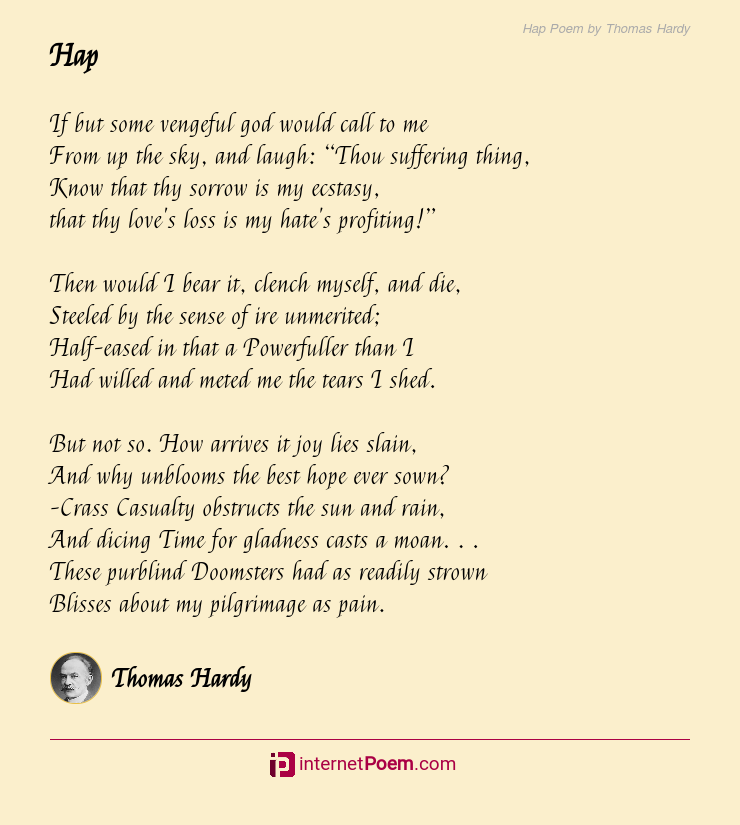
Hap: A Poetic Exploration of Love and Loss
Thomas Hardy’s "Hap" is a poignant and evocative poem that delves into the themes of fate, suffering, and the search for meaning in a seemingly arbitrary world. Its probing questions and haunting imagery resonate deeply, leaving a lasting impression on the reader.
Thematic Considerations
"Hap" explores the human condition in the face of adversity, questioning the nature of fate and the role of individuals within a larger cosmic scheme. It raises profound questions about the existence of a benevolent God and the purpose of suffering. The poem’s exploration of these themes invites readers to reflect on their own beliefs and grapple with the existential uncertainties of life.
Writing Styles for "Hap"
Various poetry writing styles can effectively convey the themes and emotions of "Hap." Some suitable options include:
- Free Verse: This style allows for flexible line lengths and rhyme schemes, providing freedom to express the poem’s abstract concepts and fragmented thoughts.
- Blank Verse: The use of unrhymed iambic pentameter creates a solemn and elevated tone, reflecting the poem’s philosophical musings.
- Lyric Poetry: A focus on subjective emotions and personal experiences allows the poet to explore the inner turmoil and questioning that "Hap" evokes.
Hap: Poetic Interpretations
Verse 1
My eyes beheld the ways of Heaven;
The pale stars in the famished air
Hung like a guilty robber’s chain
Hung like a prisoner’s ironed hair,
Which human breath would break and move,
And human finger set adrift.
Interpretation:
The opening verse presents a desolate image of the heavens, where the stars are likened to a prisoner’s shackles. The speaker’s gaze upon the sky suggests a search for answers, but only finds despair and a sense of cosmic confinement. The suggestion that human intervention could alter this celestial tapestry implies a longing for control over an indifferent fate.
Verse 2
Yet set those orbs in ridgy hoops
Where meteors burn and comets roam,
Stem them and dam them till they burst,
Compel them back into the womb,
Seal up the doors of heaven again
And bolt it like a stable-door.
Interpretation:
The second verse expresses a rebellious desire to defy the celestial order, to control the fate that seems to govern human existence. The speaker yearns to break free from the limitations of the physical world and create a new, more just reality. However, the repeated use of the word "yet" suggests that this is merely a fantasy, as the cosmic forces remain unyielding.
Verse 3
What is it that the Fates contrive,
That I am plagued with lonely thought
While others breathe in happy hive,
Their hearts unladen, souls unbought?
Interpretation:
The final verse questions the purpose of suffering and inequality in the world. The speaker contrasts their own lonely isolation with the apparent contentment of others, wondering why they have been singled out for such torment. The unanswered question echoes the poem’s central preoccupation with fate and the nature of human destiny.
How to Write Poetry About "Hap"
To write poetry about "Hap," consider the following tips:
- Study the poem closely, paying attention to its themes, imagery, and structure.
- Delve into personal experiences or observations that resonate with the poem’s core ideas.
- Experiment with different writing styles and forms to find the best way to express your interpretation.
- Use evocative language and vivid imagery to create a sensory experience for the reader.
Reading and Understanding Good Poetry
To read good poetry effectively, follow these tips:
- Pay attention to the rhythm, rhyme, and structure of the poem.
- Analyze the imagery and symbolism used by the poet.
- Consider the poem’s context and the author’s intent.
- Read the poem aloud to fully appreciate its sonic qualities.
Questions and Answers
What is the central question posed in "Hap"?
- Why is the speaker singled out for suffering while others seem to lead happy lives?
What does the imagery of the "guilty robber’s chain" suggest?
- It implies a sense of imprisonment and constraint within the cosmic order.
How does the use of free verse contribute to the poem’s meaning?
- It allows for a more fragmented and abstract exploration of the speaker’s thoughts and emotions.
Conclusion
"Hap" by Thomas Hardy is a timeless masterpiece that continues to provoke thought and inspire new interpretations. Its haunting questions about fate and suffering resonate deeply within the human experience, inviting us to confront our own beliefs and search for meaning in an uncertain world. May this exploration of the poem inspire you to create your own poetic expressions and engage with the transformative power of poetry.
Note: Please refrain from plagiarism and always credit the original author when sharing or using this content. Respecting the work of others is essential for fostering a vibrant and ethical literary community.
